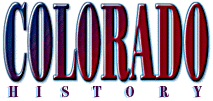
|


|
|
|
Mr. Sedivy's
More Features: |
Highlands Ranch High School - Mr. Sedivy
- Colorado History - A Guide to the Miners' Gritty Lingo Amalgamation: a process using mercury to collect fine particles of gold or silver from pulverized ore. Both precious metals dissolve in the silvery liquid, while rock does not; they can later be released by applying heat or pressure to the mercury. Bonanza: the discovery of an exceptionally rich vein of gold or silver.
Borrasca: an unproductive mine or claim; the opposite of a bonanza. Claim: a parcel of land in a gold field that a person was legally entitled to mine because he had staked it out and recorded his title. The dimensions varied according to local custom.
Claim jumping: stealing someone else's mining property - usually after it had been staked out but before it had been officially recorded. Colors: the particles of gold gleaming amid the residue in a prospector's pan after washing. Coyoting: a method used by miners to reach gold deposits resting on bedrock without excavating all of the overlying soil. After a vertical shaft was sunk, tunnels radiating like wheel spokes were dug along the bedrock.
Crevicing: removing gold from the cracks and crannies of rocks by prying it out with a knife. Cross-cut: a mine tunnel going across an ore vein, used for ventilation and communication between work areas. Drift: a mine tunnel following the direction, or "drift," of a vein; opposite of a cross-cut. Gallows frame: the wooden or steel scaffold at the top of a mine shaft carrying the hoisting rope. Gangue: worthless minerals mixed in with valuable ore. Giant powder: a miner's expression for dynamite.
Grubstaking: supplying a prospector with food and gear in return for a share of his findings. Gumbo: the bane of the miner's existence - sticky wet clay. Hard rock: ore that could be removed only by blasting, as opposed to ore that could be worked with hand tools.
High grading: the theft of chunks of ore by miners,who usually took only the valuable high-grade pieces. Horse: barren rock interrupting a vein of ore. Lode: a clearly defined vein of rich ore. The principal vein in a region was called the "mother lode." Muck: the debris left after blasting hard rock. The miner who shoveled this ore-bearing material into a car or chute was known as a mucker.
Placer: a deposit of sand, dirt or clay, often in an active or ancient stream bed, containing fine particles of gold or silver, which could be mined by washing. The word is the Spanish for submarine plain, and rhymes with "passer." Pyrite: fool's gold; a mineral composed of silicon and oxygen that is often mistaken for real gold. Quartz: a crystalline mineral, often transparent, in which gold and silver veins were most commonly found. Salting: planting rich ore samples in an unprofitable mine to attract unwary buyers.
Shaft: a vertical or inclined excavation; usually a mine's main entrance and hoistway leading to the tunnels where the ore was dug. Sluice: a wooden trough for washing placer gold. As soil was shoveled into a steady stream of water, gold and other heavy particles sank to the bottom where they were caught by cleats, known as riffles. Some small, portable sluices, or rockers, could be rocked back and forth like a cradle to hasten the washing of gold.
Sourdough: an experienced prospector; traditionally one who had the foresight to save a wad of fermenting dough to leaven the following day's bread. Stamp mill: a device that was powered by steam or water in which ores were pounded to a fine powder by heavy iron stamps, rising and falling like pile drivers. Toplander: an aboveground worker at a mine.
Turned house: a mine tunnel that took a sudden change in direction. Widow-maker: a compressed-air drill, used to bore holes for dynamite in hard rock. Prolonged inhalation of the fine dust created by early models of this drill subjected miners to a deadly lung disease called "silicosis." Winze: a passageway usually connecting two tunnels at different levels.
Cripple Creek District Labor Strikes: Early Cripple Creek District - Colorado History In Depth
- | The Cheyenne Migration
to Colorado | The Cheyenne Social Club
Fort Union Americans from the East Colorado's Role in the US Civil
War More Colorado History
Information
|
Highlands Ranch High School ![]() 9375 South Cresthill Lane
9375 South Cresthill Lane ![]() Highlands Ranch, Colorado 80126
Highlands Ranch, Colorado 80126 ![]() 303-471-7000
303-471-7000
Mr. Sedivy's History Classes
| Colorado History | American
Government | Advanced Placement Modern European
History | Rise of Nation State England | World
History |
| Home | Back to the top of page
| Site Contents |











